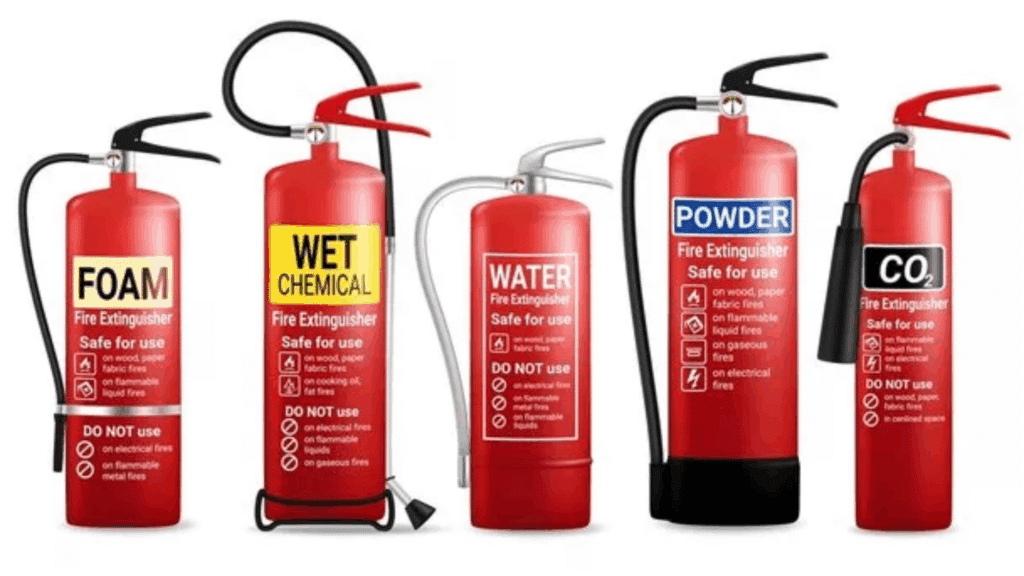Ever had that heart-stopping moment when cooking oil starts smoking a little too much?
I’ll bet most of us have been there, and it’s scary how quickly things can go from perfectly fine to dangerously out of control.
That’s exactly why I’m excited to share something that could be a real game-changer for your kitchen safety.
If you’ve never heard of Class K fire extinguishers, trust me, you’ll want to know about these lifesavers.
If you’re a restaurant owner, work in the food service industry, or simply someone who takes kitchen safety seriously, this blog will walk you through everything you need to know about Class K extinguishers.
Let’s get into it!
What is a Class K Fire Extinguisher?
A Class K fire extinguisher is specifically designed to tackle fires involving cooking oils, animal fats, and vegetable greases. Think of it as the superhero of kitchen fire safety!
These extinguishers are built to handle the unique challenges that come with high-temperature cooking fires, the kind you’ll find in busy restaurant kitchens or even your home kitchen when things get a bit too heated.
Unlike regular fire extinguishers that might spread burning oil around, Class K extinguishers are engineered to deal with these tricky grease fires safely and effectively.
They’re your best friend when cooking oils catch fire, whether it’s from deep fryers, grills, or stovetops.
How Does a Class K Extinguisher Work?
Here’s where things get really interesting! Class K extinguishers use a wet chemical agent that works through a process called saponification, basically, it turns the burning fat or oil into soap. Pretty cool, right?
Here’s how it works step-by-step:
- The Spray: When you activate the extinguisher, it releases a fine mist of wet chemical agent
- Cooling Effect: The mist helps cool down the burning oil below its ignition temperature
- Saponification Magic: The chemical agent reacts with the hot oil, creating a soapy foam layer
- Fire Suppression: This foam blanket smothers the flames by cutting off oxygen
- Reignition Prevention: The soapy layer acts like a protective barrier, preventing the fire from starting up again
It’s like having a chemical firefighter that not only puts out the fire but also creates a protective shield to keep it from coming back!
Where Should Class K Extinguishers Be Used?

Class K extinguishers are essential in any setting where cooking with large amounts of oil or fat takes place.
Commercial kitchens in restaurants, hotels, and catering facilities rely on these extinguishers due to the constant high-heat cooking involved.
Food trucks, which function as mobile kitchens with limited exits, also need Class K extinguishers for safety. School cafeterias and hospital kitchens should be equipped with them as well, given the large number of meals prepared daily.
Don’t overlook bakeries and pastry shops; frying donuts and cooking with oil still pose a fire risk.
Even corporate cafeterias and employee break rooms with substantial cooking equipment benefit from having a Class K extinguisher nearby.
Class K Fire Extinguisher Price & Specifications
Class K fire extinguishers are essential for commercial kitchens, restaurants, and other food service environments where high-temperature cooking oils are a constant risk.
| Feature | Description | Typical Range |
| Price | The cost can vary based on capacity, brand, and cylinder material. | ₹2,000 – ₹20,000 |
| Capacity | The amount of extinguishing agent the cylinder holds, typically measured in liters (L) or kilograms (kg). | 2L/kg to 9L/kg |
| Extinguishing Agent | The chemical mixture was used to put out the fire. | Wet Chemical (Potassium Acetate, Potassium Citrate, or Potassium Carbonate) |
| Body Material | The material used to construct the cylinder. | Mild Steel or Stainless Steel |
| Discharge Time | The approximate duration of the extinguisher’s discharge. | 8 – 30 seconds |
| Discharge Range | The distance the extinguishing agent can be projected. | 2 – 4 meters |
| Operating Temperature | The temperature range in which the extinguisher is designed to function effectively. | +5°C to +55°C |
| Approvals/Certifications | Standards and certifications the extinguisher must meet for safety and performance. | ISI, BIS, UL |
The size and type of cooking equipment, as well as the potential fire risks, should guide your choice of extinguisher capacity. Always ensure the product meets relevant safety standards and is installed in an easily accessible location, as mandated by fire safety codes.
Fire Extinguishers for Wood, Paper, and Fabric

Now, let’s switch gears and discuss Class A fire extinguishers.
These are the workhorses of fire safety, designed to handle fires involving ordinary combustible materials like wood, paper, textiles, cardboard, and other organic materials.
Class A extinguishers come in three main types:
- Water-based: The most common and economical option
- Foam: Great for mixed fire risks
- Dry powder: In variety, but can be messy
You’ll typically find these extinguishers in schools, offices, hospitals, homes, warehouses, and pretty much any building with standard fire risks.
They’re usually marked with a red color code and the letter “A” prominently displayed.
These extinguishers work by cooling the burning material below its ignition temperature (water types) or by smothering the fire and preventing oxygen from reaching it (foam and powder types).
Class K vs. Class A Extinguishers
When selecting the right fire extinguisher, understanding the differences between Class K and Class A types is crucial for safety and effectiveness.
The following table highlights their key features and typical uses:
| FEATURE | CLASS K EXTINGUISHER | CLASS A EXTINGUISHER |
|---|---|---|
| Main Use | Cooking oils, fats, and grease | Wood, paper, fabric |
| Common Locations | Kitchens, food service | Schools, homes, offices |
| Agent Type | Wet chemical/saponification | Water, foam, or dry powder |
| Typical Price Range | $60–$300 | $15–$40 |
| Coverage Area | Specialized kitchen fires | General combustible materials |
| Reignition Risk | Very low (creates a protective barrier) | Moderate (depends on thorough cooling) |
Choosing the appropriate extinguisher based on the environment maximizes fire safety and prevention.
Choosing the Right Extinguisher: Key Tips
Using the wrong type of extinguisher can be dangerous or even make a fire worse. Never, ever use a water-based extinguisher on a grease fire! The water will cause the burning oil to splatter and spread the fire.
- Match the Extinguisher to Your Risk: Restaurants need Class K extinguishers in the kitchen and probably Class A in dining and storage areas. Regular offices usually only need Class A extinguishers.
- Location Matters: Place extinguishers where they’re easily accessible but not too close to potential fire sources. You don’t want to have to reach over a burning stove to get your extinguisher!
- Regular Maintenance is Crucial: check your extinguishers monthly for pressure levels and have them professionally serviced annually. A fire extinguisher that doesn’t work when you need it is worse than useless.
- Train Your Team: Ensure everyone knows where the extinguishers are located and how to use them effectively.
Wrapping It Up
Class K fire extinguishers aren’t just another piece of safety equipment gathering dust in the corner. They’re your first line of defense against one of the most dangerous types of fires you can encounter.
I’ve encountered numerous kitchen accidents that could have been avoided with proper equipment and understanding.
These specialized extinguishers are made specifically for grease fires, and using any other type might escalate the danger considerably.
Don’t wait until it’s too late! Take a look at your kitchen setup today, assess your fire risks, and make that investment in proper fire protection.
Ready to upgrade your fire safety? Browse Class K fire extinguishers now and protect what matters most.














